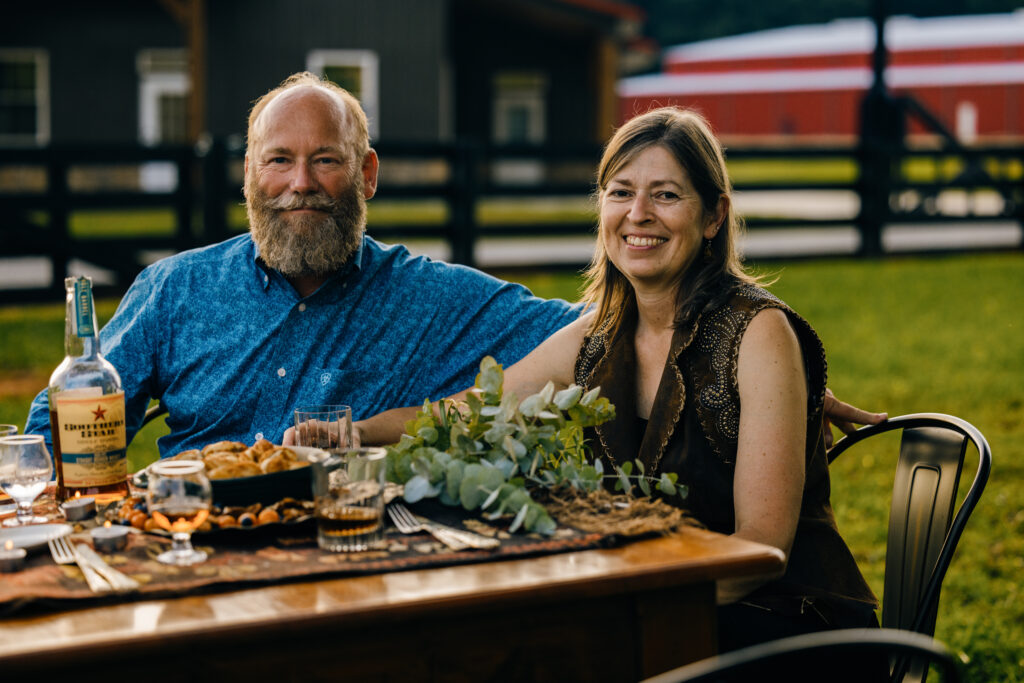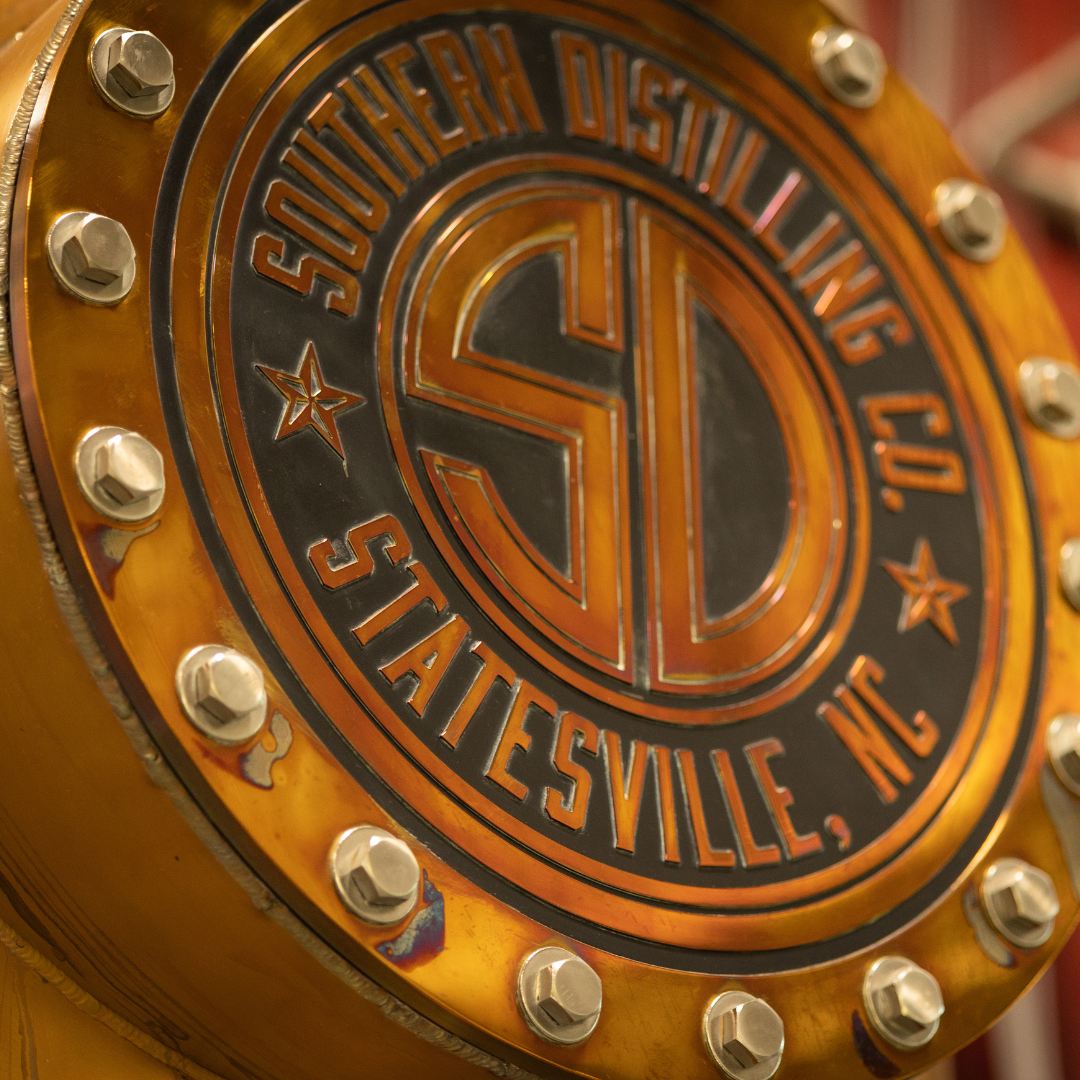“Our ideals are our possibilities.” –Anonymous
Pete and Vienna Barger truly know their stuff…I mean all of it. In the past ten years as co-owners of Southern Distilling they have addressed every detail of their distilling process and business to become the largest distilling operation in North Carolina. The distillery, located in Statesville, now operates 24/7, 360 days a year.
Southern Distilling is not simply a “grain to glass” outfit as so many distillers like to promote themselves today; they are truly a “Farm to Glass” operation, and only a few other distillers might claim that.
“We produce the majority of the grain we use,” Pete explains, and indeed ninety-six percent of the corn and rye they use is sourced from their own local farms. Only the malt and some rye must be sourced outside as their demand for it has temporarily outstripped their own supply. That is a clue to how rapidly their business is growing.
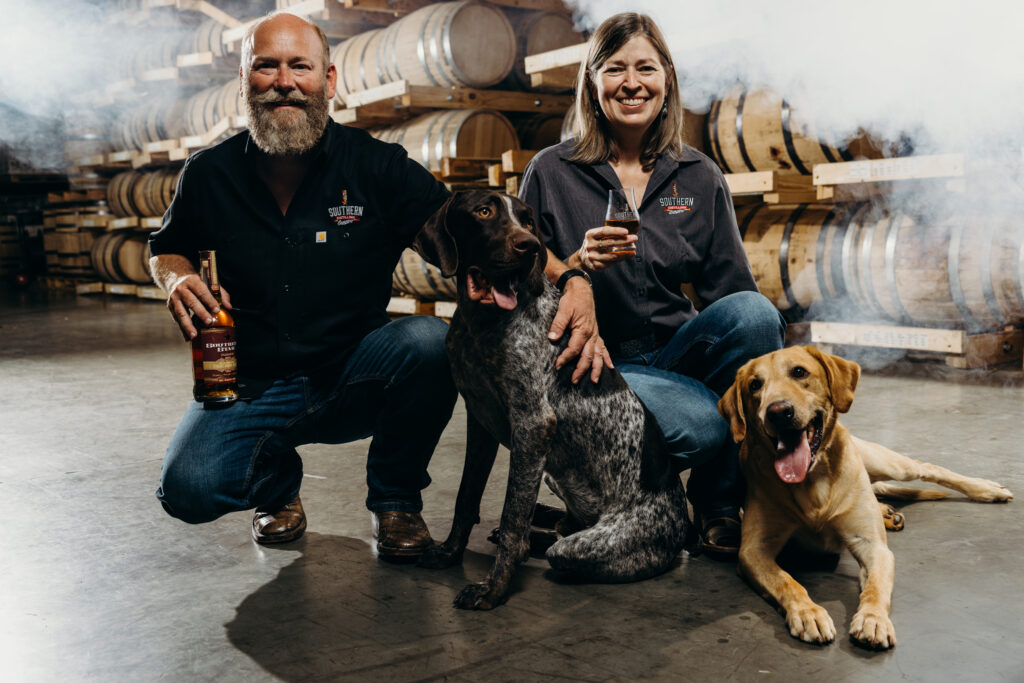
Pete and Vienna should rightly be considered pioneers in regenerative agriculture–even before it was called that. Regenerative agriculture is a conservation and rehabilitative approach farming and food production systems. These practices focus on topsoil preservation, regeneration, improving biodiversity and the water cycle, and the overall strengthening of health and vitality of farm soil. Commercial farms are adopting regenerative techniques, using “no-till” and/or “reduced till” practices.
From the start, their growing fields are no-till operations which helps prevent runoff and soil erosion. Crops are seasonally rotated which helps to naturally replenish the soil of vital nutrients to keep the soil fertile and healthy. Other measures are taken to ensure the long-term viability of their farmland. One of the main byproducts of a distillery is spent mash, and a lot of it. Again, Pete found a natural, beneficial, and profitable way to utilize it. The spent mash is a high-protein feed source which is used to supply livestock in their contract cattle feeding operation. Even though Southern Distilling’s primary objective is producing fine bourbons, they are also supporting cattle producers and providing a valuable and needed contribution to the nation’s food supply.

With so much thought and effort put into “Farm to Glass,” I asked Pete if there were plans for additional efforts at vertical integration for the distillery. He talked in depth about the market for oak barrels as an example. It was a consideration at one point to build, buy, or own the supply of barrels they use. Having explored every option, Pete explained that there was simply no way to make that work due to the vast swings in market volatility. When it comes to oak barrels, “You have to just accept it as a commodity,” Pete said. “It’s best to stay in your lane and focus on what you do best.”
Anyone who has sampled their output can tell you that Pete’s “focus on what they do best” has indeed proved to be the best course. Throughout our tour, I heard Pete repeat the words, “consistency” and “quality” more than a few times. This is because they are the primary focus of the entire process. Pete has systems in place to eliminate, reduce, or mitigate the effects of all kinds of variables that could affect the output and lead to inconsistency or issues with quality.
The distillery uses two column stills, copper doublers, and there’s a pot still for single malts. We step over to the column still and sample both the high wines and low wines right from the live tap as they are being produced. At this level, Pete explains how he chooses to give up just a bit of efficiency in order to push quality of the output to its maximum potential; a careful process of how he balances and utilizes the low wines versus the high wines of the initial run through the column still. He’s right again…the high wines sampled are indeed dialed-in and well-tuned. At the very end of the process, samples are taken and measured at the onsite quality control lab to ensure that what they are putting into barrels matches Pete’s expectations.
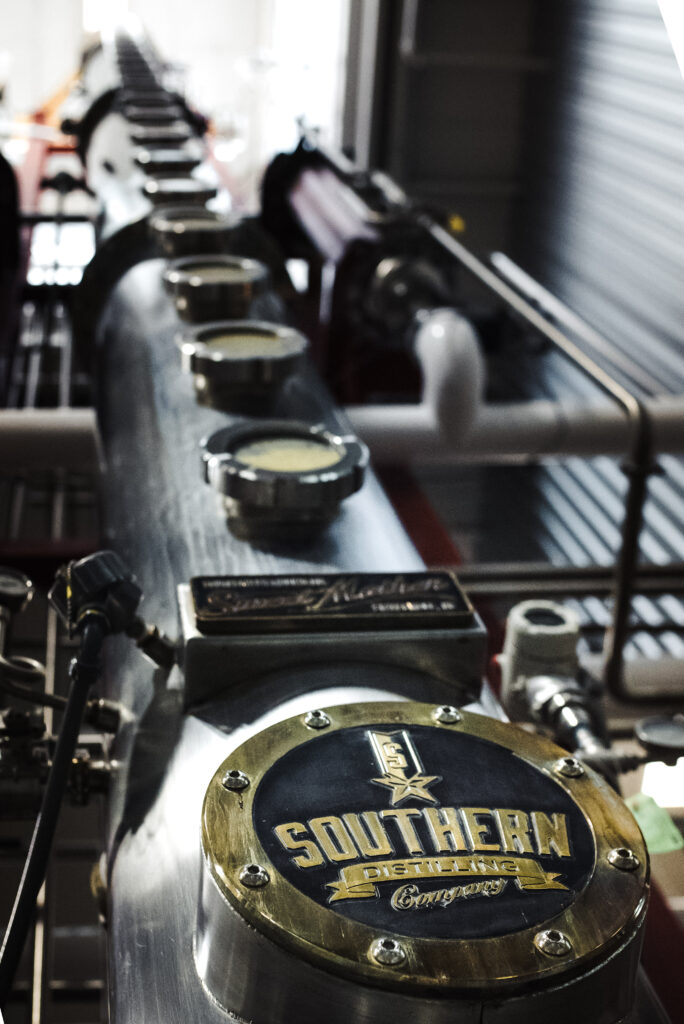
The “wizardry” employed in the distilling process is mostly digital and data-driven, with a healthy dose of clever engineering efficiency. Much of the design is based for energy and time-saving thermal efficiency, with a high priority for the consistent quality of the output. I was astonished to learn how this technology works. The distillery inputs data with what they require as product outputs from the equipment for every stage of the process. Pete tells the digital controller what temperatures, goals, and many other qualities he needs for the mash to achieve, etc. The digital controller doesn’t simply turn systems on and off at a preset time or temperature, it actively adjusts the entire line, every process on the fly to achieve the required outputs Pete established.
Frequent changes in environment — everything from fluctuations in temperature, humidity, barometric pressure, and so on — can alter what happens to the mash and other processes in the distillery. The digital control system reacts to all of it in real time to provide a consistent result for the output. All of this data is fed back and recorded, collected, and logged for future use to potentially improve operations. Pete is not only running his own grain farms, he’s also running his own data farm. Continuous improvement for the distillery is always on his mind, not that there’s much need or room for that at this stage, unless the subject turn to expansion of the entire operation.
Pete’s plans are to do just that; to expand the distillery by adding a facility behind the existing one that would allow them to increase their output by 80,000 barrels a year. A new set of rickhouses are to be constructed offsite at a nearby property purchased for the purpose. “We’re out of space,” Pete tells me after he describes the size and use of each building on his campus. It’s a good problem to have these days, in my opinion. Only a few American businesses can say this in 2024.
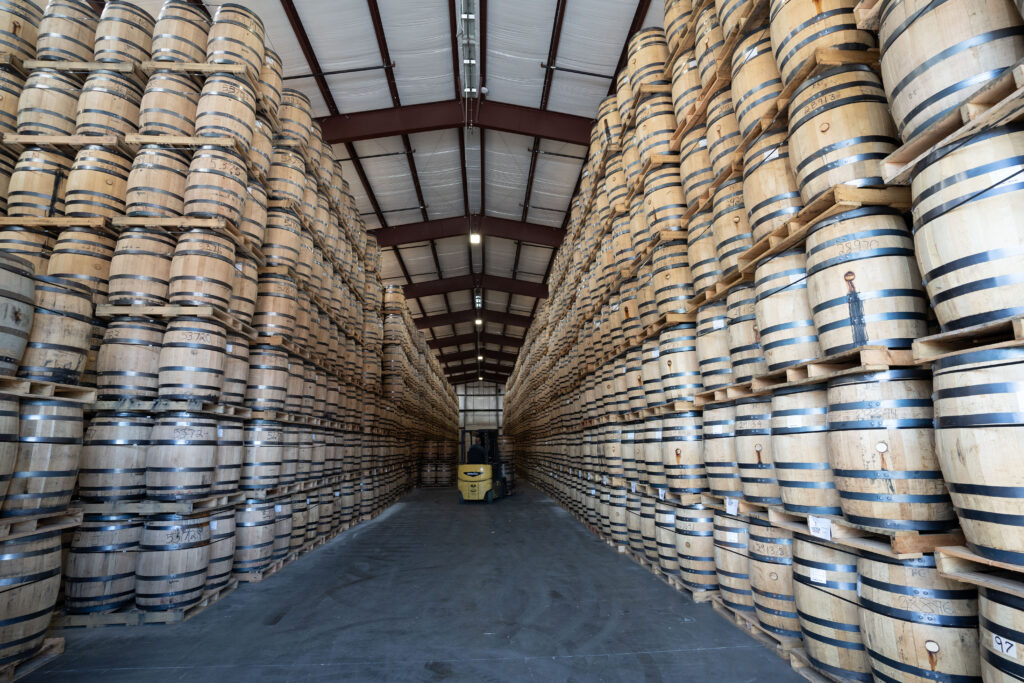
Southern Distillings’ business model is focused primarily on providing the highest quality expressions for other non-producing distilleries (NPD’s). This channel accounts for about 98% of their overall volume. It is a solid and dynamically growing channel as an increasing number of bourbon consumers are seeking authentically-produced, high-quality spirits, single barrel and barrel proof expressions. “We’re the source for many of the brands they know,” Pete says .
When I asked Pete to comment about the potential for export, he smiles. “Of course the potential is there.” He specifically mentioned two potential markets: Europe and India. He notes that the challenge with bourbon in Europe is one of spirit education about bourbon and American whiskey in general. “There’s more to American whiskey than Kentucky and Tennessee,” he says. In India he notes that the overall quality of spirits is quite poor and their consumers are ready for high quality spirits.
Pete drove me over to their nearest rick house. This is where I witnessed a grand sight; here thousands of sleepy, finished barrels are gently resting, aging gracefully with the four seasons of North Carolina, year after year. Unlike the busy production and bustle happening at the distillery, everything at the rick house is motionless and peacefully silent. The air is filled with smell of cut oak wood and angel’s share. “I like the smell of this place,” I remark as I enter. Pete says, “You should only smell oak and angel’s share…if we ever smell bourbon, we’ve done something wrong!” Smelling bourbon would mean that barrels would be leaking somewhere.
Again, I see the same care for efficiency and quality here in the rick house; barrels are stored on-end and palletized for efficiency with space maintained between rows to allow for proper air movement. Specially-designed external venting is carefully adjusted throughout the year as the seasons change. While nature and time do their work on the bourbon here, Pete leaves little to chance. Even with thousands of barrels stored here, every barrel is accounted for and its specific location is mapped and logged.
During this visit, Pete invited me to sample two of his products. We chat about our experiences with single barrel and blended “small batch” expressions. Of course, he knows there’s a demand in the market for single barrel expressions that are so popular today. With these expressions, the credit is given to the “master distiller.” He recalls a bit of whiskey wisdom that was passed on to him; “In the U.S. we spend all this time talking about the master distiller…but its usually about the blender.” Pete explained that unlike single barrel expressions, for blends, which are far more prevalent in the market the goal is more complex. The final product must become a beneficial sum of the parts where each component expression complements and completes the other in the mix. Achieving this outcome one time is one thing, but achieving is over and over in a consistent way for a brand is a talent.
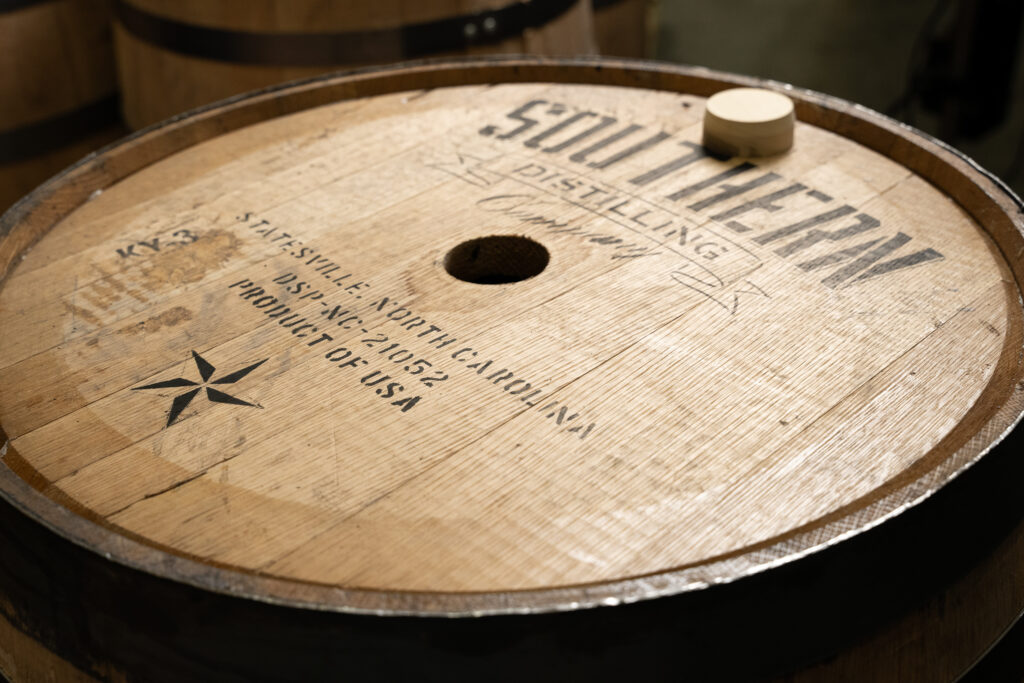
I am already familiar with their core Southern Star line of products. These are their Paragon, High-Rye Bourbons, Double Rye, and Double Shot Bourbon Cream Liqueur. Today, however, Pete had something special in mind to sample. The first sample he poured was a special edition Southern Star high-rye barrel-proof bourbon bottled as the official bourbon of the 2024 Wyndham Championship Golf Tournament in Greensboro, North Carolina.
This flavorful blend has a fine, deep amber color. On the nose is caramel and butterscotch with some baking spice notes way in the background. On the palate, the mouthfeel is full-bodied, robust as it immediately surprises with a pleasant sweetness normally associated with wheated expressions, not always with rye. Again, butterscotch is prevalent with marshmallow and vanilla notes along for the ride. The finish is pleasant and medium-long as the flavors gently mellow and linger like the sunset on a summer day. I must confess it to be among the finest blends of all that I have tasted. This is truly an expression I can recommend and I will be sad to see the last bottle sold of this limited edition.
The second offering that Pete sampled arrived in a lab bottle. It was a 112-proof wheated expression that has been finished in ex-California Zinfandel barrels. This expression will soon be available to the public. I have tasted a number of port-finished expressions, but never a Zinfandel finished product. The color of this expression is a complex deep reddish-copper, which one would expect sourced from ex-wine barrels. Because this was sample of an unfinished, yet-unreleased product, I’ll just say that if the finished product is as good (or somehow even better) than what I sampled, the bourbon world is in for a real treat! This is not an expression that you will want to miss.
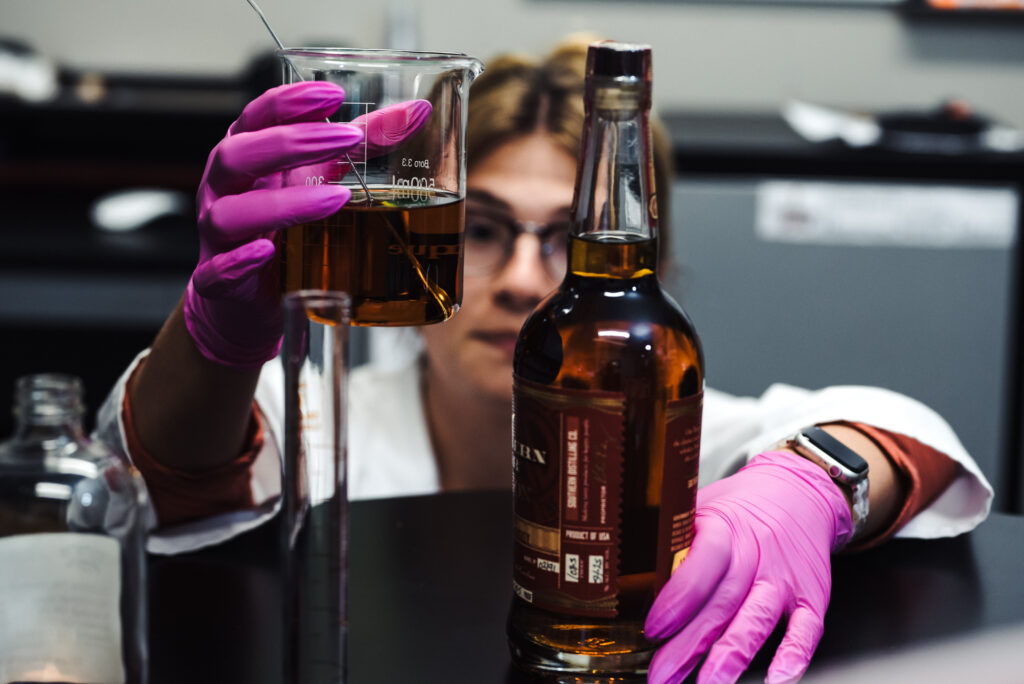
This was my second visit to the distillery and despite all that I had learned about the Bargers and their operation, I still had not yet figured out their secret to success in revitalizing the distilling tradition in Statesville. It remained a mysterious piece of the puzzle. Then I witnessed a clue. On this visit, I noticed the same sense of urgency I’d seen everywhere on my earlier visit. The folks working there moved with purpose; they were glad to be there and eager to help. All of the staff was busy attending to their roles and nobody carried the body language of “I just work here,” or “I’m having a bad day;” attitudes which seems so prevalent everywhere else you go these days. The distillery would be nothing without the people who run it every day, so why were the people so different here?
I think that the first thing to know about the Bargers’ distillery is that they formed and operate their business on four core beliefs :
- Stay true to self. We’re proud of where we’re from, of what we do, and of the spirits we make.
- Give a damn. We care deeply about three things: our people, our process, and our products.
- Dare to win. Before prohibition, Statesville was the liquor capital of the world. And we don’t take that lightly. Our aim is to carry on that legacy and put North Carolina’s best-kept secret on the map.
- Be grateful. Appreciation is at the core of who we are. We’re grateful for those we serve, for all we have, and all the goals worth striving for.
Everywhere I went at the distillery it was obvious to me that these core values were not simply words put on some plaque in the lobby of the office to impress visitors. In fact, no one at the distillery mentioned these or bragged about them (I found them on their website.) But they didn’t need to. These values hold meaning to everyone at Southern Distilling and it is clear that they drive a deep commitment in everything they do. This has proven successful as the company is now poised to expand, which will soon make them four or five times the size they are today.
Pete seems to be on a mission to educate American bourbon consumers on the merits of high-quality rye, high-rye bourbon, and wheated expressions. He mentions that rye and high-rye whiskeys were originally predominant in America before cheaper corn took over, and he’s right. I agree that the consumer is truly missing out if all they are out there chasing is ordinary bourbons. Their Southern Star brand is a rising star indeed. In the big picture, Pete and Vienna are showing the industry a successful model of efficiency and regenerative agriculture “from farm to glass,” while producing many of the finest quality spirits available anywhere. It is a tuned and balanced business that is every bit as carefully crafted as their fine bourbons.
Learn more about Southern Distilling here.
